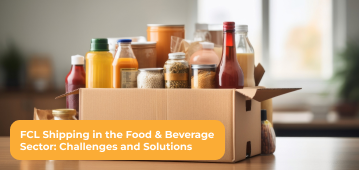Transforming Logistics through Innovations in 2022
After unanticipated disruptions in the global supply chain network in 2020, the logistics and freight forwarding industry is steadily recovering which is Transforming Logistics through Innovations.
Today, it’s poised for growth at 6.5% CAGR, from 2020 to 2027, and will cross US$ 12,000 billion by 2027. This advancement is largely fuelled by adopting Logistics 4.0 – digitization, better logistics APIs, automation, artificial intelligence (AI) and fluid communication across the supply chain.
With rising demand, businesses in logistics are turning towards transformation of their processes. Disruptive technologies are all set to give logistics of the future a facelift, enabling a digital supply network.
Let’s look at how these innovations are translating into logistics in 2022.
1. MOVING TOWARDS BETTER CUSTOMER EXPERIENCE
For a long time, logistics and supply chains weren’t considered an essential part of the customer experience journey. However, the pandemic turned that perspective upside down.
Today, omnichannel commerce is rising as a result of customer expectations that a brand be present on several channels to cater to their needs. Omnichannel businesses are adopting an ‘anytime, anywhere’ delivery approach to keep up with demand, and provide superior experience.
These expectations have trickled down to freight shipping as businesses are moving to an experience-led approach. Multichannel commerce can circumvent logistics disruptions better, and as a result, integrated systems are replacing legacy, disintegrated ones for seamless cross-channel communication among supply chain partners. They’re also incorporating shared assets, be it people or information.
2. DEPLOYING NEW TECHNOLOGIES FOR RISK MANAGEMENT
Globalisation has peaked for the logistics and trade industry. Businesses are delivering products across boundaries, and technology has played a significant role so far in reducing trade risks. Now, new technologies are taking risk management several steps further.
In 2022, companies are expanding investments in AI for automation across processes – warehousing, manufacturing, predictive analytics, planning and freight forwarding. Another area that’s benefiting immensely is inventory management. Complex flows and visibility have always been a part of the inventory system. But with AI and automation, stock can be monitored in real-time and orders delivered, smartly.
Then there are robots for performing simple tasks to help warehousing facilities. They can prepare consignments, drop products at the delivery point, and even detect or communicate with other robots in the vicinity. Similarly, self-driving trucks could be available on a global scale in the near future.
Blockchain and decentralised technologies also hold promise owing to greater security and efficiency coupled with lower costs. Moreover, they allow for better transparency in the supply chain, spanning several parties through improved logistics APIs, smart contracts and payment automation.
3. REVITALISING FREIGHT FORWARDING
It’s predicted that the freight forwarding market will grow at 4% CAGR between 2021 and 2026. This is because of growing omnichannel commerce and subsequently, increasing international trade volumes.
Specifically, the Asia-Pacific region will become the fastest-growing freight forwarding market. Although North America has led the race so far, ASEAN logistics markets are attracting investments from international institutional investors. China and India will benefit from this, quickly becoming the two countries to look out for in the region.
To keep up with this growth, emerging markets are looking at adoption of technologies. AI and automation will find their way into storage and integration of data, planning shipments, maintaining data security and enabling effective communication, to increase scale and efficiency.
Freight forwarding solutions will also become more comprehensive and one-stop in nature. Such solutions reduce costs, increase profit margins and also cut down waiting times. Moreover, they avoid a disjointed approach across the supply chain, taking care of complete logistics. ECU360’s consolidated freight shipping solutions are helping businesses overcome challenges of traditional logistics.
4. NURTURING SUSTAINABLE SUPPLY CHAINS
Awareness about sustainability is growing among several industries. Consumers, too, prefer businesses that address these concerns and are improving their internal systems. Therefore, it’s time for trade to be truly sustainable, benefiting all three elements – people, planet and profit.
When it comes to logistics, CO2 emissions are a big concern. As per research by MIT, freight transportation is responsible for 8% of greenhouse gas emissions worldwide, and emissions are set to double by 2050. To this end, freight forwarding is already making inroads in green supply chains.
The first place to focus is last-mile deliveries, which includes road transport, as they account for far more CO2 emissions than ships. Conventional trucks and vans can be replaced by battery-powered or electric transport. Investments in renewable energy will also boost growth of a green supply chain.
A misconception about having automation in supply chains is that human resources will be replaced. However, technology will only provide better capabilities. Humans will always be a key aspect of logistics. Upskilling opportunities, hybrid working, flexible contracts and diversity are all important considerations for a sustainable workforce.
CONCLUSION
Several challenges face the logistics industry today. But it’s overcoming them by deploying new technologies, building sustainable capabilities, investing in integrated freight forwarding systems and fostering better customer experience.
Logistics in 2022 and beyond will be more resilient than ever.
Like





Comments